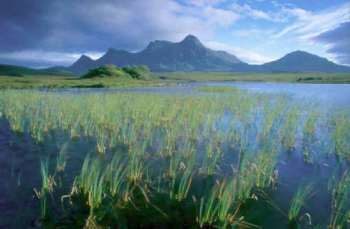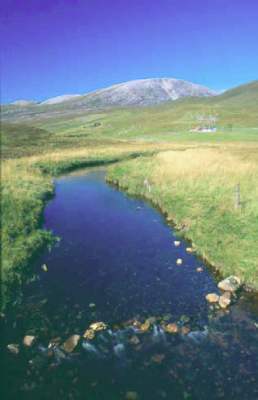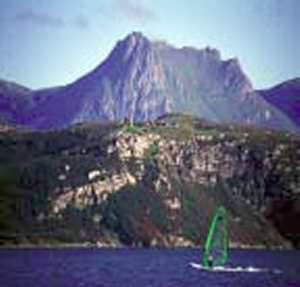 | Caithness.Org | Community | Business | Entertainment | Caithness... | Tourist Info | Site Map |
• Advertising • Chat Room • Contact Us • Kids Links • Links • Messageboard • News - Local & Scottish • News - UK & News Links • About / Contact Us • Submissions |
• Bookshop • Business Index & News • Jobs • Property For Sale • Property For Rent • Shop • Sutherland Business Index |
• Fishing • Fun Stuff • George, The Saga • Horses • Local Galas • Music • Pub Guide • Sport Index • What's On In Caithness |
• General Information • B & Bs • Backpackers • Caravan & Camping • Ferries • Getting Here • Holiday Letting • Hotels • Orkney • Pentland Firth • Sutherland • Taxis |
| N E W S F E E D S >>> |
The Sutherland
Biodiversity Action Plan - October 2003
RIVER LOCH AND WETLAND
|
1.2 RIVER, LOCH & WETLAND Introduction The landscape of Sutherland is studded with freshwater lochs, ranging upwards in size to the 18 mile long Loch Shin. Lochs are particularly numerous on the gneiss in the west, where Assynt and Eddrachillis alone muster over 1,000. These lochs are fed and drained to the sea by many miles of rivers and burns. Marshes and wet meadows occupy the flood plains of some of the larger rivers. The variation in size, depth and geographical setting of these water bodies has given rise to a varied and distinctive flora and fauna. Social and economic use of Sutherland’s rivers and lochs for diverse purposes such as hydro-electric generation, township water supply, flour mills, salmon smolt rearing and angling have all harnessed and influenced the quality or quantity of the water. Land management within the catchment also has an effect.
Specific habitats discussed in Section 2 Key Issues Issues: Agricultural and forestry run-off, fish farming and leakage from septic tanks are potential sources of nutrient enrichment, which is detrimental to our rivers and lochs. Incorrect use of fertilisers, herbicides, pesticides and sheep dip can all have a serious effect on rivers and lochs. Opportunities: In recent years, forestry techniques have improved and opportunities exist to restructure existing plantations to reduce any detrimental effects on freshwaters. Farmers and crofters must continue to be vigilant and adhere to legislation and existing codes of good practice regarding the use of chemicals.
In conjunction with several estates, RSPB Scotland and the Highland Council Ranger Service have installed islands on lochs in north and west Sutherland to provide enhanced nesting sites for black-throated divers.
B. Habitat modifications Opportunities: When carrying out in-stream or riverside works, care must be taken not to modify the structure and patterns of water flow to the detriment of freshwater habitats and species. Particular attention should be paid to culverts beneath roads and forest tracks in order to maintain water flow. Fencing the banks, planting deep-rooted trees such as willow and alder and installing water troughs will help to stabilise the riversides. Land managers and the public should be made aware of the good works that have already taken place, and of further works that can be done to improve riparian habitats along river and stream banks. Current projects: Some estates in Sutherland already undertake works to improve the riparian habitat along river and stream banks. Catchment Management Plans and detailed habitat surveys have been undertaken in several systems and a list of recommendations produced to improve freshwater productivity. |
The River Oykel is part of a large bid for EU LIFE
funding being drawn together for designated rivers by the Association of
District Salmon Fishery Boards, with support from Scottish Natural
Heritage and the Scottish Executive. The Kyle of Sutherland Board has
suggested a programme of habitat improvement measures including the
restructuring of commercial forestry in riparian areas, the planting of
broadleaves on one of the main tributaries and the blocking of hill drains
to enhance water quality and reduce siltation of the spawning beds, with
help from the Forestry Commission and other land owners.
C. Reduction in fish populations Issues: Numbers of salmon and trout have been declining due to many factors including habitat modifications and the loss of spawning beds. Opportunities: In addition to the habitat
improvements mentioned above, there are opportunities to improve fish
populations through restocking projects. Restocking with salmon and trout
should be managed to retain the genetic purity Current projects: One hatchery has been
recommissioned and another built for the rearing of
D. Flood protection Issues: The projected increase in flood frequency and intensity due to climate change is likely to heighten the demand for flood relief works. Hard engineering solutions can cause erosion, sedimentation and flooding downstream. Opportunities: When tackling flooding problems, greater consideration needs to be given to the rest of the catchment, particularly to possible downstream effects.
E. Species introductions Issues: Invasive, non-native species of fish, Opportunities: We should ensure any reintroductions
are bred from local stocks where possible, avoid releasing non-native
species in Sutherland, and take steps to eradicate problematic
F. Lack of Awareness Issues: There is a lack of awareness about freshwater habitats and species, and a lack of knowledge about the distribution of many freshwater species. Opportunities: There are opportunities for the Fisheries Trusts and Boards to work with the ranger service over the provision of guided walks and events, and the installation of bird hides or interpretation panels at strategic locations to raise awareness of the freshwater environment. Current projects: The pupils of Stoer
Primary School are working on a big project to find out ‘What lives in our
loch?’ involving the erection of a hide and the purchase of microscopes,
binoculars and other equipment to look at the loch environment. Various
freshwater education projects have taken place in Bettyhill and Achfary
Primary Schools, focussing on the Rhioconich and Strathnaver Lochs. The
West Sutherland Fisheries Trust is undertaking a project entitled ‘Salmon
in the Classroom’ to raise awareness of the life cycle and habitat
requirements The Kyle of Sutherland Board is also considering establishing a salmon interpretation centre in Bonar Bridge to inform the local community and visitors about salmon management issues, establish links with local primary schools and raise awareness of the importance of salmon and the freshwater environment in general.
|













